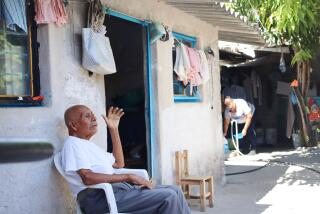Routed During the War, Ansar Returns to Join in Iraq Attacks
The men carried dollars, euros, a flashlight and five fake Italian passports. They descended the dry, brown mountains, following twisted paths past campfires of nomads and shepherds, and slipped into town in July. People in this part of northern Iraq are especially wary of strangers; the police were summoned and the four men surrendered in the marketplace.
The men -- two Kurds, a Palestinian and a Tunisian -- are guerrillas in Ansar al Islam, according to local security officials. Blending in with religious pilgrims and traveling on smuggling routes, the men were bound for central and southern Iraq, where the U.S. says Islamic militants and Saddam Hussein loyalists are staging attacks on civilians and killing American soldiers.
U.S. officials say that Ansar, the Al Qaeda-linked militant group that was chased from its bases in the north in the first weeks of the Iraq war, is regrouping and spreading across the nation, becoming one of the parties responsible for the wave of terror against Americans and their allies. The violence is believed to be the work of insurgent cells that include former members of the Baathist regime and nationalists resisting occupation.
“A lot of [Ansar guerrillas] are in Baghdad,” U.S. civilian administrator L. Paul Bremer III recently told reporters. “If Ansar decides to move, they’ll move big.”
Some local authorities dispute the belief that Ansar has the sophistication, tactics and manpower to orchestrate a countrywide terrorist campaign. About 250 of Ansar’s estimated 700 fighters were killed in attacks by U.S. and Kurdish forces in the spring, officials said. Its mountain strongholds were destroyed and its weapons caches, manuals and bombs seized. Hundreds of its members escaped into Iran or hid along the Iraqi-Iranian border. Its leaders, some of them wounded, vanished.
But there is little doubt that Ansar has recalibrated its mission since March and is now a small but lethal threat to Western targets. American officials often make little distinction between Ansar and the Al Qaeda terrorist network. The groups have similar goals and a history of cooperation, and the characterization fits U.S. thinking about the increasing influence of foreign extremists in Iraq.
Some Ansar guerrillas, including three killed by police last week in northern Iraq, are attempting to join other Muslim extremists in operations against the U.S.-led coalition forces, according to Kurdish intelligence.
“There is a link between Ansar and some of what’s happening in the south of Iraq,” said Mohammed Haji Mahmud, the chief of a northern Iraqi socialist party that earlier this year negotiated the surrender of 26 Ansar fighters. “But not to the level being reported in the international media. Ansar cannot operate to that extent. They don’t know the terrain in the south.”
The Bush administration had alleged that Ansar was running a “poison factory” capable of producing chemicals for terrorist attacks throughout the region and in Europe. Washington also asserted that Ansar provided a link between Al Qaeda and the Hussein regime.
Those characterizations, which helped make Washington’s case for war, were disputed by some European intelligence agencies.
The “poison factory” lacked sophistication and was housed in a small cinderblock building bearing brown granules and ammonia-like scents. Tests by U.S. laboratories revealed traces of chemicals including hydrogen cyanide and potassium cyanide, substances usually used to kill rodents.
So far, no significant evidence has emerged that Ansar and Al Qaeda cooperated with the Hussein regime to launch terrorist attacks against Western targets.
Deciphering the extent of Ansar’s role in terrorism in Iraq is tricky in a region infused with rumors, murky intelligence, hidden agendas and overlapping political interests.
The case of one spy in northern Iraq illustrates the problem. He worked for the local socialist party and was passing on intelligence to Iran and indirectly to the Patriotic Union of Kurdistan, or PUK, which controls the eastern portion of northern Iraq. The PUK in turn supplied intelligence to the United States. The Socialist Party recently discovered that the spy also worked for Hussein’s Baath Party.
Ansar was formed from the merger of several Kurdish militant sects operating in the mountains along the Iraqi-Iranian border. During the U.S.-led war in Afghanistan in 2001, between 50 and 100 mostly Arab Al Qaeda fighters fled to Ansar camps for sanctuary.
Ansar quickly became an Osama bin Laden surrogate as its leaders modeled the group’s training and tactics, religious philosophy and instruction for potential suicide bombers after Al Qaeda. Ansar grew more rigid, and its Kurdish members were influenced by the Arab contingents arriving from Afghanistan.
After scattering during the U.S.-led attack against them this spring, as many as 400 Ansar fighters fled to caves and villages in a 50-mile stretch of highlands along the border and inside Iran. The group has apparently transformed itself from a guerrilla army to a band of terrorist operatives. Many members are in Kurdish-controlled Iranian towns such as Mariwan, Pawa and Sina. The fighters, according to Kurdish officials, travel in cells of no more than four and receive instructions from a fighter known as Dr. Omar. The strength of their leadership is uncertain.
Two of their principal leaders -- Ayub Afghani, a bomb maker, and Abdullah Shafi, a strategist -- are believed to be in Iran. A third leader, Abu Wael, left northern Iraq with a small contingent of fighters shortly before the U.S. invasion and is said to be in Baghdad, according to a senior Kurdish intelligence officer. U.S. forces in Baghdad recently captured six men described as “Ansar financiers.”
“This is not only the work of Ansar,” said Haji Mahmud, the socialist party chief. “Ansar is masterminded by the global mission of Al Qaeda.”
Al Qaeda’s influence on Ansar became apparent this year. After several failed bombings and assassination attempts, Ansar’s terrorist wing succeeded in February and March with two suicide bombings that killed seven people and wounded 24. Bomb vests and four cars laden with explosives and rigged for suicide attacks were discovered in Ansar strongholds after the group fled advancing U.S. and Kurdish forces.
According to phone intercepts by Italian investigators, Ansar was receiving assistance from Abu Musab Zarqawi, a Bin Laden ally who specialized in biological and chemical weapons.
The recent arrest of the four men here in Qalat Dizah is another indication, according to Kurdish intelligence, that the predominantly Kurdish members of Ansar are assisting Arabs sneaking into Iraq from Iran and Syria. On Aug. 20, U.S. troops arrested an alleged Al Qaeda operative in Iraq who possessed 11 surface-to-air missiles and acknowledged that he had trained with Ansar guerrillas.
Muslims in northern Iraq say the U.S. and the PUK are exaggerating the strength of Ansar to keep pressure on Islamic groups.
“Ansar received a very big defeat this year,” said Mohammed Hakim, an official with Komaly Islami, which calls itself a moderate Islamic organization.
“It’s not likely they are carrying out the attacks they are being blamed for. It is in the interest of some to amplify the size of Ansar. The U.S. sees Ansar as Al Qaeda in Iraq and the U.S. is relying heavily on the PUK, which has a vested interest against political Islam.”
From his hilltop bunker above the town of Biyara, Ali Sofi Hama Amin doesn’t consider Ansar to be much of a danger these days.
Biyara was Ansar’s headquarters, and villagers are still clearing away debris from the U.S. cruise missile strikes. Hama Amin and his seven Kurdish soldiers scan the mountains daily for Ansar patrols that once moved freely beyond the town’s blue-domed mosque. The mountain border with Iran rises in the blue haze. Below, the valley is rocky and brown.
“We’re told Ansar exists in parties of twos and threes, but we haven’t seen any,” said Hama Amin, a thin man with gray in his mustache. “I don’t think they exist in larger numbers. They’re small groups out to do sabotage. I don’t think they’ll last for long.”
Hama Amin and his men battled Ansar for months. They said the group made flamethrowers that could shoot fire up to 50 yards and rigged electrical poles with bombs. Many Ansar fighters, rather than give up during battle, killed themselves, he said.
That fervor emerged last Wednesday in the northern city of Sulaymaniyah when an Ansar fighter, known as Mullah Namo, and two other Islamic militants jumped on a roof and battled more than 100 Kurdish police and security forces. Kurdish intelligence officials said they had been tracking Namo -- who trained in Afghanistan -- and suspected that he was planning to attack an Internet cafe frequented by U.S. soldiers.
After several hours of negotiations, Namo agreed to surrender. As police approached the house, Namo and the two militants opened fire, killing a young girl and a colonel in the security department. Namo and his accomplices were killed in the ensuing battle. Before the shooting started, Namo yelled:
“I don’t believe you or your religion.... I know at the end of the day I will die and two virgins will lift me by the arms into heaven!”
*
Times staff writers Alissa J. Rubin and Tracy Wilkinson in Baghdad and Bob Drogin in Washington contributed to this report.
More to Read
Start your day right
Sign up for Essential California for news, features and recommendations from the L.A. Times and beyond in your inbox six days a week.
You may occasionally receive promotional content from the Los Angeles Times.







